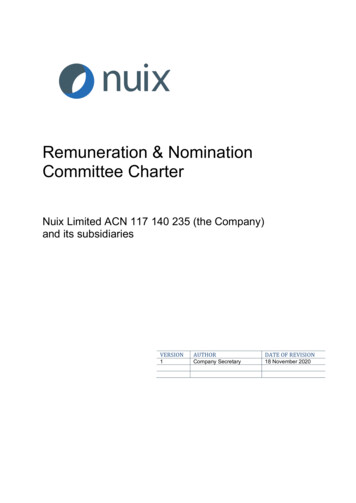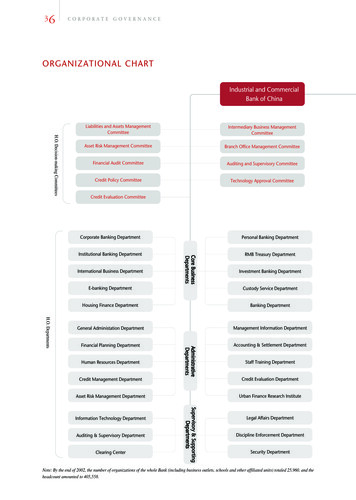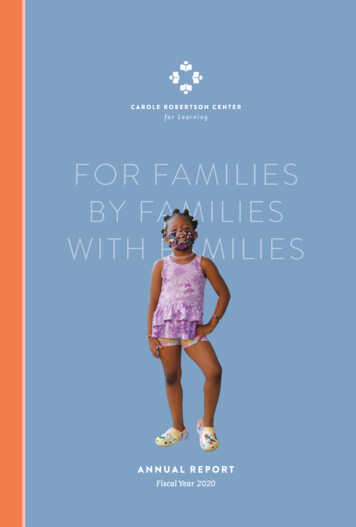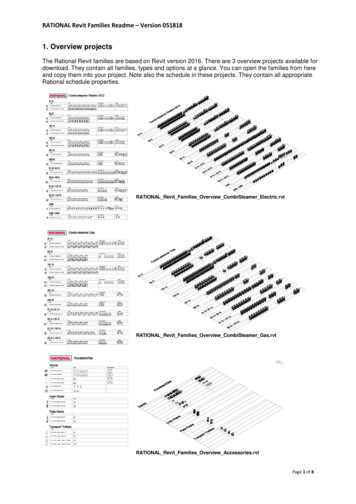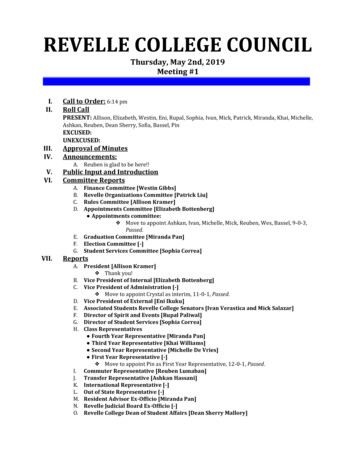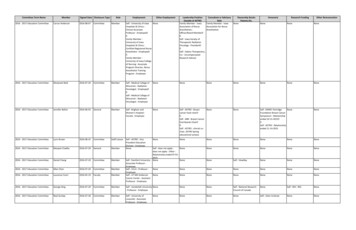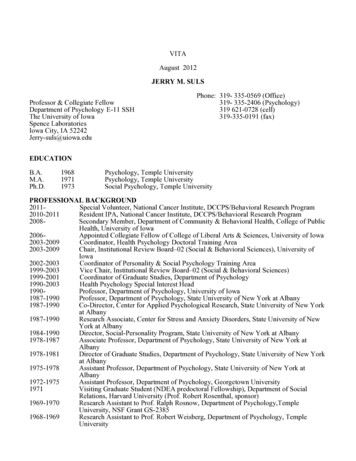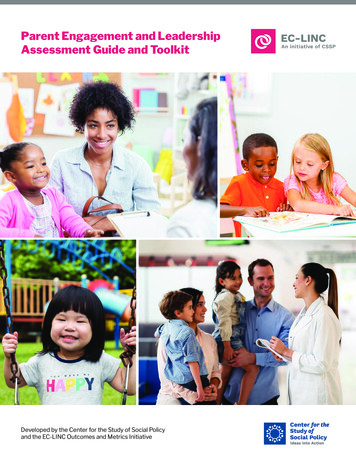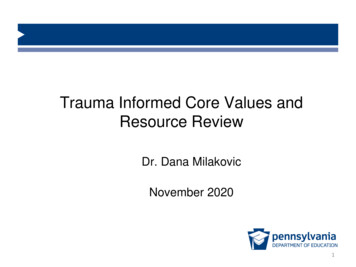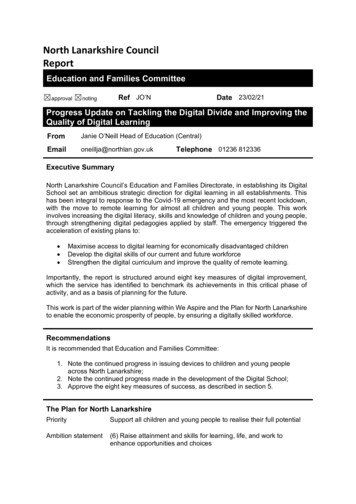
Transcription
North Lanarkshire CouncilReportEducation and Families CommitteeRef JO’N approval notingDate 23/02/21Progress Update on Tackling the Digital Divide and Improving theQuality of Digital LearningFromJanie O’Neill Head of Education (Central)Emailoneillja@northlan.gov.ukTelephone 01236 812336Executive SummaryNorth Lanarkshire Council’s Education and Families Directorate, in establishing its DigitalSchool set an ambitious strategic direction for digital learning in all establishments. Thishas been integral to response to the Covid-19 emergency and the most recent lockdown,with the move to remote learning for almost all children and young people. This workinvolves increasing the digital literacy, skills and knowledge of children and young people,through strengthening digital pedagogies applied by staff. The emergency triggered theacceleration of existing plans to: Maximise access to digital learning for economically disadvantaged childrenDevelop the digital skills of our current and future workforceStrengthen the digital curriculum and improve the quality of remote learning.Importantly, the report is structured around eight key measures of digital improvement,which the service has identified to benchmark its achievements in this critical phase ofactivity, and as a basis of planning for the future.This work is part of the wider planning within We Aspire and the Plan for North Lanarkshireto enable the economic prosperity of people, by ensuring a digitally skilled workforce.RecommendationsIt is recommended that Education and Families Committee:1. Note the continued progress in issuing devices to children and young peopleacross North Lanarkshire;2. Note the continued progress made in the development of the Digital School;3. Approve the eight key measures of success, as described in section 5.The Plan for North LanarkshirePrioritySupport all children and young people to realise their full potentialAmbition statement(6) Raise attainment and skills for learning, life, and work toenhance opportunities and choices
1.Background1.2Digital technology is recognised as making a significant contribution to learning andteaching practices within North Lanarkshire. Previous papers to the Education andFamilies Committee have highlighted that when used appropriately and with staff beingsupported, digital technology enriches learning and teaching, helps to raise levels ofattainment, and helps address learning loss.1.3Digital approaches to learning and teaching have increased in significance within ourlearning environments through the COVID-19 pandemic. The establishment of theDigital School, which incorporates the new Virtual Classroom and delivers training toteachers and school leaders, has been integral our digital strategy.1.4This strategy is underpinned by the Plan for North Lanarkshire, which sets out a clearambition that digital transformation should be responsive to the needs of all and enablethose within North Lanarkshire to access the services they need.1.5This renewed and essential focus on digital learning, through North Lanarkshire’sDigital School includes interactive curricular content in the virtual classroom. Theinnovative NL Virtual Classroom supports the digital curricular offering for all stages ofPrimary. There are also specific Virtual Classrooms for S1 – 3, ASN and Gaelic.1.6In addition to North Lanarkshire’s Digital School, Education Scotland has made anational online curricular offering to support remote learning. For learners within theBroad General Education this is through E-Sgoil and Education Scotland websites. ESgoil also contains information for those in the Senior Phase, which includes a numberof supported study sessions with the offer being added to on a regular basis.1.7Scholar, another well-established online study platform, continues to support learnersin the Senior Phase. All North Lanarkshire Senior Phase young people can haveaccess to this. The Senior Phase Digital Classroom is facilitating on-line learning forAdvanced Highers, as well as through the West On-Line platform (West Partnership).1.8During the COVID-19 pandemic Scottish Government have further developed theirguidance for schools on the delivery of remote/digital learning and teaching. Educationand Families guidance reflects current entitlements and expectations.1.9In July 2020 Scottish Government announced a programme of funding (ConnectingScotland) for local government to distribute 30 million worth of devices andconnectivity solutions for children and young people. North Lanarkshire Council wasawarded 1.6 million as part of this. At the time of writing, we are awaiting furtherinformation on the planned further investment by Scottish Government in digitallearning, with the recent announcement of another 45 million to support it.1.10The Education and Families Committee has overseen and approved the strategic andoperational approach to developing digital learning and teaching to meet the needs ofschools and learners in response to the COVID-19 emergency and beyond.2.Report
In planning for the future of digital learning and teaching within North Lanarkshire andto support the recovery of education following the COVID-19 emergency, Educationand Families established a Digital School. This focuses on developing five areas: Tackle the digital divide experienced by young people – develop equity ofaccess to technology and connectivity to engage fully in learning at home.Improve communication to families – develop guidance andcommunications to support families to create a learning environment at homeImprove CLPL – Further develop training programmes to enhance the skillsknowledge and confidence of staff in delivering learning digitallyImprove the curriculum – Align current digital learning and activities to ensurea consistent and progressive curriculumImprove the use of data – develop systems to track use of and engagementwith digital learning to inform school improvement and learner journeys.2.1Device Deployment Planning2.1.1As part of the Plan for North Lanarkshire, through the Digital NL workstream, Educationand Families already had plans to expand digital access for disadvantaged pupils.2.1.2At the time of the first lockdown (March 2020) Gold Command agreed an approachthat incorporated the existing council plan for Digital NL with the opportunity providedby Connecting Scotland. This was subsequently ratified by Education and FamiliesCommittees in May and November 2020. Through this, plans were agreed to releasedevices and connectivity solutions as part of a planned programme to those youngpeople receiving clothing grants. Appendix One shows this plan in graphic form.2.1.3The initial North Lanarkshire bid for support through the Connecting Scotlandprogramme, was made on the basis of the Connecting Scotland grant award fromScottish Government of 1.6 million, which was estimated initially to provide around5000 devices and up to 1500 connectivity solutions. There is potential to flex this withinthe contract should the profile of cost and need change.2.1.4At the time of writing this report, under the device deployment plan the followingprogress has been made in (Phases 1 – 2): 2.1.53259 devices issued to children and young people1479 internet connectivity solutions issued.The next phase (3A) of deployment began in January 2021. As with previousprogrammes of issuing devices, schools have been asked to consider those childrenand young people most at risk from factors of vulnerability and resultant learning loss.Education and Families staff continue to work with partners in Business Solutions andexternal providers to secure and finalise devices for release.2.1.5 The remainder of the devices has been allocated to schools for this next phase andare currently being issued. Additional funding from government should allow anadditional number of devices (1253) to be provided between March and June (3B).2.1.6 Children and young people in priority groups such as those working with the VirtualSchool (Care Experienced Young People) and Pathways Programme have all beenissued with a device. The priority for deploying devices has been to those children,
young people and families most disadvantaged and this is shown in the table below,illustrating the number of devices issued across the lower SIMD.DEVICE AND CONNECTIVITYDEPLOYMENT6040200SIMD 1SIMD 2SIMD 3RequestedSIMD 4SIMD 5Issued2.1.8 Members are asked to understand that in procuring, purchasing, building anddistributing these devices and connectivity solutions, there is a significant work-flowissue which is being managed by the service, as part of the device deploymentprogramme, supported by Business Solutions.2.2Digital School2.2.1 To ensure effective support and challenge mechanisms are in place, Education andFamilies has established the Digital School. Since August content has been createdby a range of teams who support improvement. These include groups of staff whooperate as part of the Scottish Attainment Challenge programme (Pedagogy Team andLearning Hub Education Support Officers) and Pathfinder School Staff (funded fromthe additional group of teachers who were employed during the pandemic (24). Contentcreated during lockdown (March – June 20) has transferred to the new Digital School.
2.2.2Planned learning content has been created across the levels of Curriculum forExcellence and includes the main curricular areas of Literacy and Numeracy, as wellas social subjects and Science, Technology, Engineering and Maths (STEM).2.2.3In addition to the curricular content, there have been many guides created to supportstaff, children and young people and families in using digital tools and engaging withdigital learning. These are being further developed to include video guides.2.2.4All schools and establishments have been regularly supported with Digital Learningand Teaching Guidance, supporting the development of digital learning and teaching,remote learning and child protection.2.2.5Glow, the Scottish online platform hosted by Education Scotland is the main site usedby schools across North Lanarkshire. This is the universal offer to all children andyoung people gives them access to Microsoft Office 365, in school and at home.2.2.6The graph below shows the increase in Glow usage from January 2020 to January2021. Unique users are individuals with Glow accounts who have signed in each month(both staff and children). The number of sessions charts the times these users haveused Glow for different types of learning. There has been a significant increase in Glowusage since the start of the Covid-19 lockdown in March 2020.2.3Virtual Classroom2.3.1 The Virtual Classroom is a completely online and interactive platform for children andyoung people. The format of the learning has been designed, where possible, forindependent learning and experiences which can be accessed in addition to the classlearning experiences provided by school staff.2.3.2 Each Virtual Classroom will include the following curricular areas: Literacy – EBooks Reading, Writing Tasks, Spelling/Phonics tasksNumeracy – Number Talks task, within number and beyond number activities.
STEM – Each fortnight there will be a focus on specific Experiences andOutcomes and planned learning.Health and Wellbeing – Using the organiser of Mental, Social, Emotional andphysical wellbeing learning tasks planned linked to Healthy Schools2.3.3 In response to the period of remote learning announced by the Scottish Governmenton 19 December all primary children were given access to the Virtual Classroom.Content which is refreshed and updated every Friday. A weekly programme ofcurricular support materials is available, differentiated to meet learners’ needs.2.3.4 There will be weekly communications on the Council’s social media channelshighlighting the learning available for the week.2.3.5 Children, young people and teaching staff have made excellent use of embedding theVirtual Classroom into their remote learning offer. By 12 January 10,000 learners hadbeen added as members. Microsoft Teams has a limitation of 10,000 for membershipof areas. Therefore, the Virtual Classroom migrated to a Sharepoint portal from 25January. From this point, visits rather than membership is measured.2.3.6 The Virtual Classroom has now been created in a Microsoft Teams SharePoint. Thisallows unlimited member use and stores all learning content securely within Glow.2.3.7 Throughout January the Virtual Classroom was further developed to include rooms forASN, Gaelic and S1-3 learners.2.3.8The infographic below documents highlights of the Virtual Classroom by 1 February.On a single day in February there were over 16,000 visits to Virtual Classroom bypupils, parents and staff. The Digital School also monitors usage throughout the dayand whilst most activity is in school time, it can be accessed at any time of day or night.
2.3.9The table below shows the way in which colour coding is used to be able todifferentiate the ages and stages of learning, to allow young people to explore theVirtual Classroom from a child-centred viewpoint.Tile ilacZebraBord-sanais2.4Primary/StagePrimary 1Primary 2Primary 3Primary 4Primary 5Primary 6Primary Senior Phase Digital Classroom2.4.1 Members previously approved the installation of a Digital Classroom at AirdrieAcademy. The Digital Classroom enhances remote learning for learners at the SeniorPhase undertaking Advanced Highers or specific Highers, which have a lower uptakefrom learners and usually only those in S6 e.g. Psychology.2.4.2In response to the COVID-19 pandemic Education and Families accelerated itsplanned use of Digital Classrooms in the senior phase consortium arrangements.Appendix 2 shows the schools who are delivering digital learning to remote learnersand the number of young people taking part.2.4.3The table below shows the numbers of young people engaging in digital consortiumarrangements which were in place from September 2020. In addition to AdvancedHigher and Highers, Foundation Apprenticeships and Early Learning and Childcareare also delivered through virtual learning and Microsoft Teams.Type of Curricular CourseHigher and Advanced HigherFoundation ApprenticeshipEarly Learning and ChildcareTotal NumberNumber of Young People Learningthrough Digital Delivery165249774912.4.4Airdrie Academy continue to use the Digital Classroom through the current period ofremote learning to deliver 2 of the Advanced Highers and a further 3 Higher subjectsto remote learners.2.4.5To enable the expansion of the Digital Classroom, all schools, apart from AirdrieAcademy, have been using Microsoft Teams as the delivery method. Education andFamilies has been able to fund and secure installation of a further 2 digitalclassrooms. One in Greenfaulds High and one in the Wellbeing Hub of BellshillAcademy which will support wider cluster learning and interventions.2.4.6To further enhance the senior phase digital offering, schools now have access toWest On-line School, the West Partnership’s digital platform. They also have access
to the SCHOLAR platform, running by Heriot-Watt University, which supportslearning in the senior phase.2.4.7SCHOLAR usage across North Lanarkshire schools has shown a steady increasingtrend in the period between August - December 2020 (table below) with almost15,000 young people accessing Scholar web pages by the week beginning 23rdNovember 2020.2.4.7.1 The total number of students accessing Scholar in this period was 2332. Incomparison 1309 students accessed Scholar in the period between March - June2020, an increase of 78%.2.4.7.2 87% of secondary schools have shown an increase in the number if studentsaccessing Scholar between the 2 periods – 224 students in one school being thebiggest increase.2.4.7.3 In terms of discrete subjects – National 5 and Higher Chemistry along with National 5Computing Science are the subjects with the biggest usage across NL although mostsubjects have seen an increase in the number of young people accessing Scholarcontent.2.4.8Members will be given further updates in due course on the learning and teachingexperiences of young people, staff and parents engaged in Senior Phase DigitalClassroom learning experiences.2.5Professional Learning2.5.1 The Digital School provides an enhanced Continuous Lifelong Professional Learning(CLPL) programme for all staff, including bespoke support for those delivering digitallearning at the Senior Phase and meeting specific learners’ needs digitally.
2.5.2In response to the Scottish Government announcement on 19 December of a periodof remote learning, the Digital School planned and delivered an intensive programmeof Professional Learning for all those working with children (6 – 8 January 2021) inpreparation for the commencement of remote learning on 11 January 2021.2.5.3The training highlights were:8 different sessions were offered to staff, with each running on 3 different occasions.Staff were not limited in the number of sessions they joined and could join both fromin school and remotely.The total number of participants across all the sessions was 2336, with one trainingsession on 7th January having 219 participants.80% of staff have evaluated the training as useful to very useful.2.5.4There will be a continued bespoke training programme to meet the needs of staff andpractitioners in February. As in the January programme this will be delivered by NLstaff including Pathfinder Staff and pedagogy team. An illustrative report on trainingsessions provided in February 2021 is provided in Appendix 4.2.6Continuous Improvement2.6.1 Education Scotland announced on 13 January, it would undertake a national pictureinspection of schools’ capacity to deliver remote learning. The Digital Schoolcontinues to offer North Lanarkshire Schools best practice support in their deliverymodels and curriculum. Phase 1 of this was engagement with 5% of schools acrossScotland (eight in North Lanarkshire) in the week of 18 January.2.6.2On 20 January, Education Scotland confirmed a rolling programme of review of online learning. At the time of writing 24 schools will have engaged with HMI inconversation on remote learning: 15 Primary 6 secondary 3 ASNAs part of this process Glenboig Primary and Redburn School have been identifiedas being examples of best practice nationally.2.6.3Initial conversations with school leaders focused on: The journey by the school in remote learning from March 2020 to February 2021Support for vulnerable children both in school and remotelySupport and guidance from Education and familiesLocal and National Programmes of CLPL
Next steps both nationally and locally.2.6.4On Thursday 4 February, Education Scotland published plans for Phase 3 of theprogramme of review. This programme will focus on local authorities. The details ofthis are included in the table below.National overview of practice(Themes Addressed)SampleReport DateLocal authority approaches to assuring a sample of 5 /6 localthe quality of remote learningauthorities, with case studies26 FebruaryApproaches to supporting pupilengagement, participation andmotivation during remote learningAs above05 MarchSupport the health and wellbeing oflearners and their families, staff andthe school community.As above12 MarchApproaches for providing learning forchildren and young people withcomplex learning needsAs above19 MarchUsing feedback from learners andparents to adapt and makeimprovements to the delivery andquality of remote learningAs above26 MarchAssessing learning and providingAs abovefeedback to learners on progress withinsecondaries01 April2.6.5The Digital School further supported all schools with the improvement of remotelearning, by issuing a standardised planning format to all establishments for return on8 January. These plans detail how schools will deliver remote learning and supportchildren, young people and families with their learning.2.6.6Key messages from schools on-line planning process conducted by all schools were: Schools are communicating with families using more than one means, to meetdiffering needs All schools have planned for regular keeping in touch sessions with children andyoung people All schools have communicated their planned learning programmes to families All schools are using data to identify children and young people who are notengaging with remote learning and have plans in place to overcome barriers All schools are reviewing their remote learning to meet changing needs and tocontinue development of high quality learning experiences.2.6.7Education and Families, Education Support Officers and Digital School Leads havescrutinised these plans (applying a RAG status) and engaged school leaders insupport and challenge conversations. Evaluation of schools’ planning is on-going.
2.6.8All schools are now tracking and reporting on participation in digital learning. Fromweek beginning 18 January schools have been using Glow Class Insights, or itsequivalent in the platform used by the school (See Saw), to trackengagement/participation in the digital part of the remote learning offer.2.6.9 To develop the knowledge and tracking around the data being gathered schoolscompleted a pro-forma tracking engagement in digital remote learning for the wholeschool (18 and 25 February) and specific year groups/stages (25 February).2.6.10 Tracking of learner engagement /participation in digital learning will be quality assuredby Education and Families Managers. This will also inform weekly discussion withCluster Innovation and Improvement Leads ensuring the needs of vulnerable youngpeople are met.2.6.11 The tables in section 8 off the performance report provided in Appendix 3 describethe proportion of all children engaging in digital learning (with vulnerable pupils shownas a subset). It should be stressed that this data is being published for members priorto the full ranges of data quality checks being completed, and therefore the informationcontained herein is subject to change.2.6.12 Work is being done by Education and Families Managers to review this data andconsider ways to best support schools to further drive up levels of participation in online and remote learning, especially for vulnerable pupils. Daily monitoring of theattendance of these groups in school and planning meetings at cluster level on aweekly basis focus on the needs of this group. A separate paper on GIRFEC to thiscommittee covers that group.2.6.13 Through Family Groups of schools, peer review conversations are being organised toensure that there is effective self-evaluation at school level to support improvement.2.6.14 In further enhancing the commitment to supporting all schools with digital learningand teaching and families in accessing remote learning a Digital Inclusion Lead wasappointed in December 2020, who started in post on 6th January 2021.2.7Feedback from Pupils on Digital Learning2.7.1996 pupils across North Lanarkshire Council completed a questionnaire at the end ofterm in 2020, that consisted of questions surrounding their experience of digitallearning. All of these pupils had required to self-isolate for at least one period of up tofourteen days at a time between August and December 2020.2.7.2556 primary pupils and 440 secondary pupils completed the survey. It should benoted, that for a number of these responses, where young children were involved,parents/carers or teachers assisted pupils in the completion of the questionnaires.2.7.3Key findings from the survey are provided below. These findings were the basis foraction taken by staff in January:
95% of pupils stated that they have access to a digital device (desktop, laptop, tablet) athome.5% sometimes had no access to the internet or had no internet access at all71% pupils felt they had the right amount with only 12% suggesting they hadtoo much43% of pupils said they received work daily during their self isolation; 21% said2 or 3 times a week, 25% said weekly and 11% said otherMost pupils either strongly agreed (28%) or agreed (51%) that the content oflearning they received was appropriate for their current stage at schoolPupils said that they would be either very confident (43%) or fairly confident (36%)that if they were to self-isolate or receive digital learning from their school again, itwould be good quality.The content of learning varied between new learning (42%) and revision (41%), with asmall amount reporting ‘other’ (17%).2.7.4In their comments, pupils expressed different views regarding digital learning. A lot ofthe pupils liked certain aspects of learning at home including feeling safer from thevirus at home and enjoying learning on the computer. Some pupils had technicaldifficulties including remembering their passwords; problems with finding the learningmaterials online; access to Teams and more than one person in the householdneeding the laptop for lessons. In terms of motivation, feelings were mixed. Somepupils felt that they were disinterested and feel it is not as effective as classroomlearning. A varied response to the workload as some pupils indicated they had toomuch work across subjects whereas others said they would like more work and moreof a challenge. This could differ between subjects and teachers, as well as thosepupils who were in the process of completing exams and those who were younger.Pupils have suggested that they would like live or recorded lessons and feel that thiswould be helpful in them completing work and providing an explanation of the tasksthat they are being asked to complete.2.7.5Members are reminded that this survey was done at a moment in time in December2020, with a group of young people who had been required to learn in a differentway. In such circumstances, the school had no lead in time to prepare young peoplefor this process, which could often occur with only a night’s notice. Significant workhas been done on the basis of the feedback from before December to inform thecurrent period of on-line learning for all but a few pupils.2.7.6Plans are in place to survey the opinions of young people and parents as regards theoffering in place from 8 January. This will be done on a population wide scale.
However, it should be noted that in Pupil Youth Forum and Parent Council Chairforum discussions, there has been an overwhelmingly positive response to the workdone by schools, with pupils recording significant improvement in the delivery of online learning and this being confirmed by parents, who praised the work of the VirtualClassroom and the commitment of staff. These forums will be used by the seniorleadership of Education and Families to monitor progress for the duration of theperiod of on-line learning and to inform future planning.2.85G Immersive Classroom2.8.1BT, a business partner of North Lanarkshire Council, is developing a 5G digital projectat the Muirfield Centre, Cumbernauld. 5G and the technologies which can be used withthis connectivity have the potential to transform learning experiences for a range ofchildren and young people across North Lanarkshire. The focus of this project is anImmersive Classroom, giving children, young people and wider community users a 360degree digital experience.2.8.2 The key aims of this project are to: To provide virtual learning experiences to enhance learning and teaching To enhance pupils’ experience of digital technology Improve literacy across learning through collaborative shared experiences andstimuli To provide opportunity and stimulus for interdisciplinary learning To provide distraction therapy through sensory and experiential virtualtechnology To develop experience and knowledge of the world of work2.8.3The Muirfield development was delayed due to COVID-19, however it went live inFebruary 2021. Kildrum and Carbrain Primary Schools, and Glencryan and Redburn
(ASN) Schools will be part of the 5G Immersive Classroom pilot, which is beginning inFebruary with a programme of staff training.3.Equality and Diversity3.1Fairer Scotland Duty Progressing the Digital School recommendations are in line withFairer Scotland duty guidelines. The actions from the recommendations areaddressing disadvantage and barriers to learning and attainment. Ensuring equity ofaccess to the curriculum and skills for learning life and work. The ScottishGovernment’s Connecting Scotland programme is augmenting our work in this area.3.2Equality Impact Assessment has been undertaken in line with council policy.4.Implications4.1Financial ImpactAll digital expenditure to date within the current Financial Year has been met by theDigital Inclusion Grant from the Scottish Government of 1.6m, flexibility withinexisting grants and existing budget resources. The Scottish Government haverecently announced an additional 45m of support for Remote Learning. NLC’s shareof this is still to be confirmed. This money is to support councils until the end of 20-21Academic session. A further 25m will be made available in 2021-22.Future expenditure on digital development will also require the successful outcome ofthe Capital bid of 4.33m to support the creation of 22 Digital Classrooms and thewider ongoing refresh requirements for Laptops, desktops and Whiteboards.4.2HR/Policy/Legislative ImpactThis work is being brought forward in light of the national Connecting Scotlandprogramme. The Digital School CLPL programmes are being co-designed with theTalent and Organisational Development Team. Finally, the whole Digital School /Digital Classroom initiative has been a key component of the Digital NL programme.4.3Environmental ImpactThe movement of pupils’ consortium arrangements for Advanced Highers to on-linedelivery reduces the numbers of taxis being deployed and therefore reduces thecouncil’s carbon footprint.4.4Risk ImpactA risk matri
Digital School includes interactive curricular content in the virtual classroom. The innovative NL Virtual Classroom supports the digital curricular offering for all stages of Primary. There are also specific Virtual Classrooms for S1 - 3, ASN and Gaelic . 1.6 In addition to North Lanarkshire's Digital School, Education Scotland has made a



